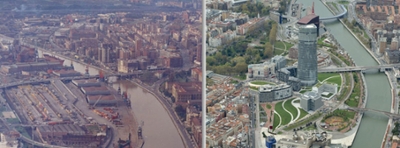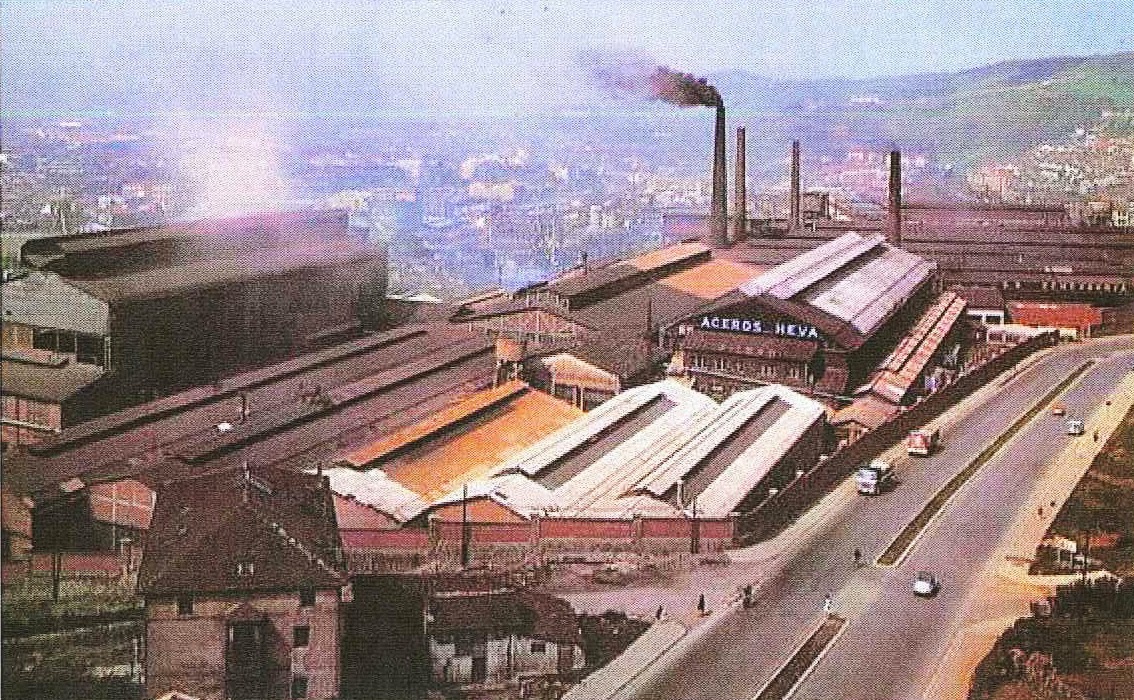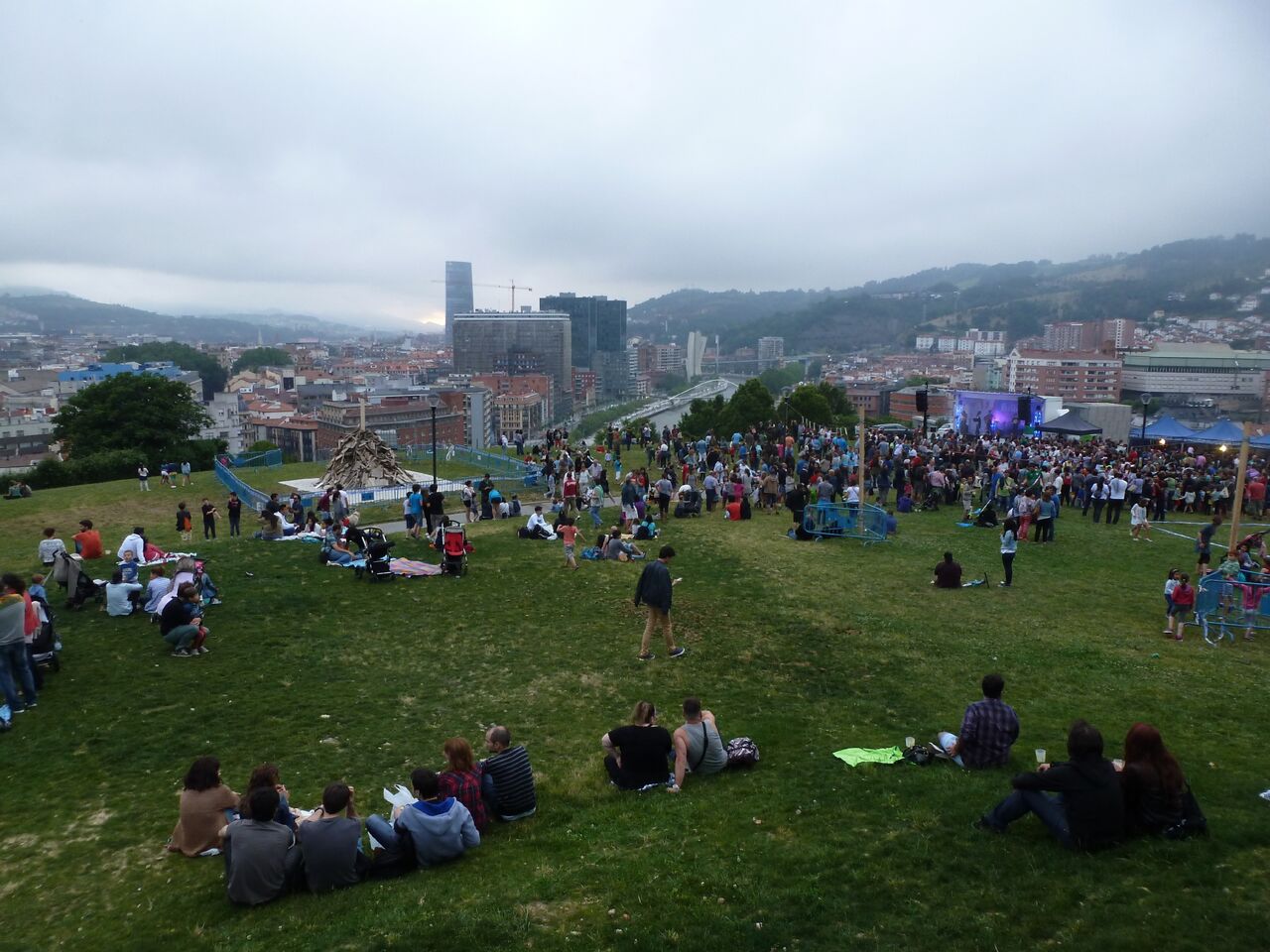PSF: Sense of Place in Spain, “El Botxo”*

The riverside neighborhood of Abandoibarra, before and after Bilbao's transformation. Photo credit: Bilbao Ría 2000.
* “El Botxo” is a nickname for Bilbao, or more specifically the river valley that cradles the city. “Tx” makes a ch sound in Euskera (the language of the Basque people), so “Botxo” is pronounced “Bocho.
“The Bilbao you see today has nothing to do with the Bilbao I grew up in,” said the woman. “Nothing to do.”
It was my second day in Bilbao, capital of the semi-autonomous region of the Basque Country, called Pais Vasco in Spanish and known as Viscaya among its inhabitants. The city is nestled in a narrow river valley, a patchwork of red rooftops and pedestrian staircases among lush green hills.
Many people in the United States have heard of the Basque Country only in relation to the ETA, the nationalist terrorist group that fought for the region’s independence in the 1990s. Coming in as a foreigner, I was full of questions. What did the Basque language sound like? What makes Basque culture distinct from the more general “Spanish” culture I had inherited from my Latin America roots and learned about in my classes? What did it feel like to walk around in Bilbao, the largest city in a region marked by geographic isolation, particularly harsh linguistic and cultural oppression during Franco’s regime, and a history of separatist sentiments?
My project is to visit four cities, each in a different region of Spain, and learn about the elements that shape their sense of place. For example, what makes Bilbao Bilbao? What are the historical, social and physical influences that have created the unique experience of walking through Bilbao’s streets, interacting with its people? After visiting the cities, my project will explore the details and feelings that make up their sense of place through fictional stories. Stories are how we make sense of the world and share it with each other, how we explain why things are the way they are. What story could I tell to illustrate what makes Bilbao the place that it is? I started wondering about this as soon as I arrived at the Abando train station, as I walked along rain-darkened cobblestone sidewalks and passed bilingual street signs on my way toward the full, vibrant Bilbao river.
There were two things I always did shortly after arriving in the cities I studied: wander around the town for hours, and buy myself a proper map.
In El Casco Viejo, the historic neighborhood of Bilbao, I found my way into a bookstore and asked an employee if they sold maps of the city. She looked through the geography section and found maps of Madrid, Barcelona, the neighboring region of Asturias, and Spain as a whole, but no maps of just Bilbao.
“What exactly are you looking for?” she asked.
This question sparked a long conversation, occasionally interrupted by fellow customers, that became one of my favorite moments of my entire trip throughout Spain. I explained that I wanted to learn about Bilbao’s history and Viscaya in general, about what made the city the way it is. Visibly intrigued, the woman began pulling books and maps off the shelves.
“Bilbao has changed a lot in the past fifteen, twenty years,” she began, showing me a collection of historic photographs featuring an industrial town full of chimneys billowing with smoke. Bilbao, for most of the twentieth century, was dominated by the iron industry: mining, processing, and shipping ore out into the Atlantic. In the 1990s, a severe economic downturn left citizens destitute and desperate for change.
“Before, everything was grimy and gray. Outsiders knew us for terrorism; we were very isolated, no foreigners ever came here. Then we had a couple mayors, one of them died recently, who decided Bilbao would advance through culture, not industry.”
The employee pointed at a picture of the riverfront, with gray buildings, a shipyard, and smoky skies. “I lived through all this,” she said, looking me in the eye. “It all happened very quickly. Now everything on the riverfront is well maintained, new paint, new bridges.”
Then she showed me the face of modern Bilbao: an entire book dedicated to the history and construction of the world-famous Guggenheim museum.
“The first big change was the Guggenheim. When they first started building it, my friends and I complained. We thought, who needs a Guggenheim? There were so many more urgent things to spend money on. But look where we are now.”
If you Google Bilbao, one of the first things to pop up is a gleaming, shiny modern art museum made of angular metal sheets perched on the edge of the Bilbao river. The Guggenheim modern art museum is a symbol of the city’s transformation, signalling the transition into a modern city, with an economy of services that encourages tourism.
“Us Bilbaoinos had to get used to having foreigners around, had to learn some phrases in English, what a ‘bill’ was.”
Other large-scale initiatives to make Bilbao less industrial and more modern followed suit. A massive factory on a hill overlooking the historic center was demolished, cleaned, and replaced by Etxebarria Park, a community green space complete with sports facilities and beautiful views; one smokestack remains, as a tribute to the memory of the past. A subway system was built, connecting Bilbao to its wider metropolitan area along the river valley and extending all the way to the Atlantic.

“Bilbao is full of beautiful architecture,” the bookstore employee continued, showing me a map highlighting notable buildings in the area. “We didn’t even recognize our own city when they finished. The facades used to be covered in soot. Everything was gray, and then they started a new initiative to scrub all these buildings clean, repaint the facades, make the city beautiful for visitors.”
As more people bustled into the store, speaking all sorts of languages, the woman began refolding the maps and sliding the history books back onto their shelves.
She sighed. “Well, I hope that helps. I should get back to work.”
I thanked the woman and retreated to the bookstore’s children’s section, where I began furiously taking notes, focusing on the most remarkable theme I had encountered in her story and in the city itself: large scale, sudden, and empowering transformation. My mind turned to possible story threads: how had the people and governors of Bilbao put such drastic change in motion? Who might have been left behind by all the changes, or disagreed with opening up to foreigners? How did this notion of modernity and progress affect the people of Bilbao and greater Viscaya’s relationship to Spain?
I left the bookstore with a whirlwind of history and possibilities in my mind, no map, and an entire city to explore. The Guggenheim gleamed in the distance.
Extebarria as it is now, a thriving green space where community members await the annual Night of San Juan bonfire. Photo credit: Guananí Gómez

